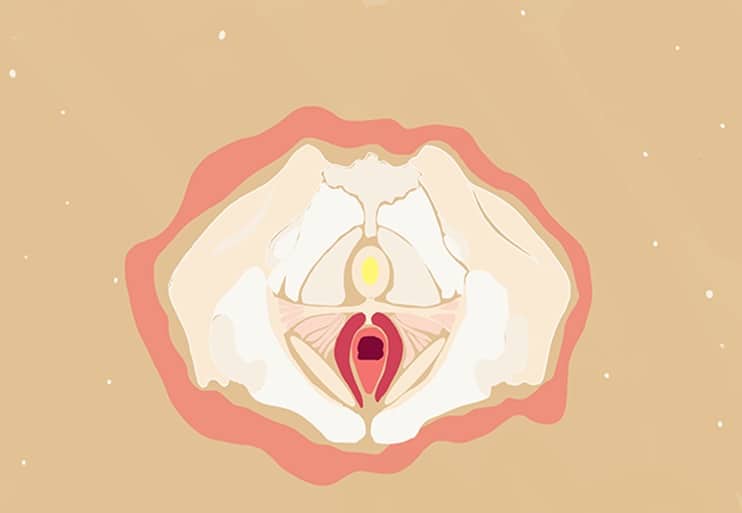Published 16 September 2024
-
Written by Katherine Maslowski, MBChB, PGDipOMG and MSc

Reviewed by Dr. Abhinav Singh
Fact checking standards
Key takeaways
You might have heard of your pelvic floor (or you might not have, and that’s ok). Today we are going to talk about what your pelvic floor is, why it is important and pelvic floor exercises you can do to strengthen it.
What is my pelvic floor?
The pelvic floor is the term used to describe the muscles around your vagina (or penis if you have one), your bladder and your bottom. The muscles attach to your tailbone (coccyx) at the back, your pelvis at the sides and the pubic bone at the front. Everyone has a pelvic floor regardless of what kind of genitals they have. People tend to talk about the pelvic floor more as it relates to women though as it can be affected by things like pregnancy and childbirth. Women also have three “holes” in the pelvic floor whereas men only have two. This article will focus on the pelvic floor in people with a vagina, but pelvic floor exercises can be beneficial for everyone.
What does it do?
The pelvic floor (as the name suggests) forms the “floor” of the pelvis. It supports the organs that sit in the pelvis and the abdomen, like your bladder, intestine, uterus etc. They also support these organs during activities that increase the pressure in your abdomen like coughing, laughing or lifting heavy things. The pelvic floor is also important for making sure you only go to the toilet when you want to. This is call continence and incontinence (when you leak urine by accident) can happen as a result of a weak pelvic floor.
Why is it important to keep my pelvic floor strong?
Pelvic floor exercises can be beneficial in the long term and the short term. They can help reduce the chance of urinary incontinence and pelvic organ prolapse. Keeping your pelvic floor strong can also increase your enjoyment of sex.
Where are my pelvic floor muscles?
The pelvic floor muscles are around the vagina, anus and urethra (where you pee from). You can feel them working if you try to stop passing urine (peeing) midway through.
NOTE: Only do this to find your pelvic floor muscles. It is not very good for your bladder to stop midway when you are peeing.
What causes the pelvic floor to weaken?
A lot of things that weaken your pelvic floor are normal parts of life, like ageing, pregnancy, or childbirth. Other things might also increase the chance of having a weak pelvic floor such as obesity, having a long-term cough or chronic constipation, or a job/hobby that involves a lot of heavy lifting.
If the pelvic floor is weak this can cause trouble holding onto your urine (pee), being unable to control passing wind or pain during sex.
How can I exercise my pelvic floor?
Make sure you are sitting down to do pelvic floor exercises and make sure you are breathing naturally (not holding your breath). You can do these exercises lying down if that is more comfortable but try to avoid doing them standing up.
Try to squeeze the pelvic floor muscles 10-15 times. Ideally, we want to hold each squeeze for 5-10 seconds This might feel like a really long time at first and that is ok. You will be able to hold for longer the more you practice. If you can only hold for a few seconds at a time, then start with that. Make sure you only hold for as long as you can while still breathing normally. If you need to hold your breath you are holding the squeeze for too long.
You can increase the number of squeezes over time too but ALWAYS make sure you relax in between squeezes. These muscles are not designed to be contracting strongly all the time, so it is important to let them relax in between.
Don’t try to tighten your abdominals or thighs while you are doing the pelvic floor exercises as it will work against your pelvic floor.
This makes sense if you think about your belly (abdominal cavity) as a box with muscles on all sides. If you tighten your pelvic floor you are “lifting” the floor of the box. If you also tighten your abs then you are pushing in one of the walls as well. This will then push down against your pelvic floor and make it harder for these muscles to work.
If you are having trouble identifying your pelvic floor muscles
Different people describe these exercises in different ways. These are a few of the descriptions I have heard:
- Imagine you are trying to stop peeing midway through
- Think about trying to lift the area around your vagina off the seat
- Try to stop a fart (although this is a slightly different part of the pelvic floor than the one we are trying to work)
And possibly the most creative I have heard is from Adam Kay’s book This is going to hurt:
“Imagine you’re sitting in a bath full of eels and you don’t want any of them getting in”
You can also check you are using the right muscles by putting a couple of fingers into your vagina. You should feel the muscles squeezing your fingers when you do the exercise.
If you are really struggling or not sure if you are doing the exercises correctly then you can see a pelvic floor physiotherapist. They specialise in these kinds of exercises and will be able to help you. Correct technique is very important, so it is best to check if you are unsure.
These exercises work best when done correctly so you may not see a difference if your technique is not correct. It is always best to have someone show you in person how to do these if you are not sure.
How long does it take to feel a difference?
It can take several months to notice a difference with pelvic floor exercises.
By doing the exercises 3 times a day, every day, you should start to notice a difference in a few months.
If you are doing the exercises to help with symptoms like incontinence or pain during sex then keep going even when your symptoms get better. It is great if you can get into the habit of doing your pelvic floor exercises every day. Then you will be much more likely to avoid problems in the future.
Note on “pelvic floor trainers”
Yoni eggs have increased in popularity recently. If you haven’t heard of them, they are small eggs made of crystal (or other materials) that some people recommend putting in your vagina overnight to “strengthen your pelvic floor”. There are many reasons why this is not a good idea. One is that asking your pelvic floor to contract constantly for hours on end is not helpful and may even be harmful. Also, the material that a lot of these eggs are made from is porous (has tiny holes in it). This means that bacteria can get into the eggs and makes them very hard to clean properly. Leaving anything in the vagina for long periods can increase the risk of infection or even toxic shock syndrome.
There are some tools that are available for helping with pelvic floor exercises. These are different from yoni eggs though. They are only for use while you are practising your pelvic floor exercises. Some are inserted into the vagina and then measure the pressure of the muscles to give you feedback on whether you are doing the exercises properly. Physiotherapists who specialise in women’s health can help with these as well.
What if I am pregnant?
Pelvic floor exercises are very important in pregnancy. As you can imagine, a growing baby is putting a lot of pressure on the pelvic floor. This can lead to complications either immediately after having a baby or later in life. Urinary incontinence (when you leak urine involuntarily) or pelvic organ prolapse (when the uterus or vaginal walls move downward) can occur in women who have had babies in the past.
Strengthening your pelvic floor before, during and after your pregnancy can reduce the risk of these things.
Pelvic floor after birth
Pregnancy can put a lot of pressure on your pelvic floor, as can having a baby vaginally. It is important to keep your pelvic floor strong after you have had a baby. The exercises are the same, regardless of whether you have just had a baby.
NOTE: there is no strong evidence that having a caesarean section reduces the impact on the pelvic floor compared with a vaginal birth. This is because the pressure of the growing baby during pregnancy is probably the most important factor, not how the baby is delivered.
What about sex?
People can find sex gets better if they strengthen their pelvic floor. It can increase the sensitivity of the area and lead to stronger orgasms. A strong pelvic floor can also reduce pain during sex.
For men, strengthening the pelvic floor can even help with symptoms of erectile dysfunction.
Can the pelvic floor be “too strong”?
Yes.
This is much less common than a weak pelvic floor but if the muscles are too contracted this can also cause issues. This is called a hypertonic pelvic floor and can cause issues with emptying your bladder or bowel or cause pain during sex. It is important to seek help from a doctor or physiotherapist for this.
When should I see a professional?
If you have symptoms such as difficulty holding onto your urine (incontinence), difficulty emptying your bladder or your bowel, a feeling of heaviness or a bulge in your vagina or pain in your pelvis when exercising or during sex then it is important to see a professional. Start with your GP and they might refer you to a specialist if needed. Pelvic floor exercises can be helpful for most of these symptoms but it is important to check there isn’t anything else that needs to be done.
Disclaimer: This website does not provide medical advice. The information, including but not limited to, text, graphics, images and other material contained on this website are for informational purposes only. No material on this site is intended to be a substitute for professional medical advice, diagnosis or treatment. Always seek the advice of your physician or other qualified health care provider with any questions you may have regarding a medical condition or treatment and before undertaking a new health care regimen, and never disregard professional medical advice or delay in seeking it because of something you have read on this website.
Disclaimer: This website does not provide medical advice. The information, including but not limited to, text, graphics, images, and other material contained on this website is for informational purposes only. No material on this site is intended to be a substitute for professional medical advice, diagnosis, or treatment. Always seek the advice of your physician or other qualified healthcare provider with any questions you may have regarding a medical condition or treatment and before undertaking a new healthcare regimen, and never disregard professional medical advice or delay in seeking it because of something you have read on this website.
Written by
Katherine Maslowski, MBChB, PGDipOMG and MSc
Reviewed by

Dr. Abhinav Singh
Dr Singh is the Medical Director of the Indiana Sleep Center. His research and clinical practice focuses on the myriad of sleep.





